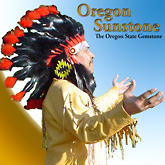Sunstone History
Oregonians may recognize the multi-colored gem as Oregon sunstone, the state’s official gemstone since 1987. Formed and crystallized in ancient volcanic flows, Oregon sunstone is unique among gem feldspars due to the “Schiller Phenomenon” caused by millions of microscopic copper platelets found in each stone. “The Schiller makes the stone appear to glow with its own internal light source,” said Talley, the mining company’s vice-president of marketing. “Oregon sunstones retain this glow when viewed from a great distance or even by starlight.”
Sunstones are also encountered in India, Russia, Finland and Norway, but only in Oregon is the stone found of gemstone quality, and only in the Ponderosa Mine is it found in such a spectacular array of colors. Native Americans used the transparent, glittering gems as trading stones and to enhance their medicine wheels, sacred bundles and burial sites. In 1992, major jewelers H. Stern and Tiffany & Co. added the Oregon gem to their lines, calling it American Sunstone.
At 6.5 to 7.2 on the Moh’s hardness scale, Sunstone competes favorably with Tanzanite, Topaz, Amethyst, Emerald, and other well-known gems, and with prices ranging from $20.00 per carat to as much as $2500.00 per carat, based on color, cut, clarity, and weight; there is an Oregon sunstone available for everyone.
Oregon sunstone is an all-American, all-natural gemstone, Desert Sun Mining & Gems does not enhance its gemstones in any way with chemicals, irrigation, heat or oiling. Created by nature — pure, radiant, and simply beautiful.

